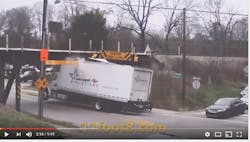Truck drivers don't like to see crashes, except for one: the so-called 11foot8 bridge – aka the Canopener Bridge. They can't seem to get enough of it.
Millions of people, many of them truckers, have watched the tops of trucks peeled back by the Gregson St. Bridge, the nearly 100-year-old, low-clearance railroad trestle in Durham, NC. About 8 years ago, Jürgen Henn, who works in a nearby office, set up a camera to record the action. A year later, he installed a camera across the street to record crashes from another angle. Since then, cameras have caught several incidents a month.
A 10-minute compilation of all crashes uploaded to YouTube between 2008 and 2016 has logged almost 2.5 million views. The 11foot8 website itself has had almost 10 million views. The bridge's conquests have even spawned a side business called 'crash art,' sales of twisted pieces of truck parts left behind in the street after vehicles have slammed into a crash beam installed by the North Carolina Railroad Company to protect their span.
However, the days of Schadenfreude may be coming to an end. After years of trying different ways of keeping trucks from tangling with the bridge, the North Carolina Department of Transportation may have found the best solution. We interviewed John Sandor, deputy division traffic engineer, NCDOT – Division Five, about what they've done and what other jurisdictions and drivers can learn from their experience. Following is an edited conversation.
When did the bridge first come to NCDOT's attention?
I wasn't here then but I was told it was probably between 15 or 20 years ago but it wasn't anything out of the ordinary in those days. [When the bridge was built, there were no minimum clearance standards. Trucks were much lower, too.] I think Durham has seen such tremendous growth in the past 15 years. We've seen traffic volumes go up. I think it's always been an issue but one that was considered normal at some period of time. Now that there are more people driving through there than before, and the incidents have gone up as a result of that. At least that's my theory. It got to the point that we felt compelled to begin throwing some safety money at it about ten years ago. Our first fix was considered advanced for that time; it was a flashing light sequence that indicated you had tripped the sensor indicating that you're too tall.
Did it work?
It really didn't have a lot of teeth. It just flashed the yellow lights along with the static sign hanging there and didn't do much.
How many incidents were you having?
I think we were averaging somewhere around two a month. It was probably about 15 or 16 a year. Some months were worse than others. We'd have a couple of months where there was nothing. I think what really started to bring a lot of attention to it was its internet fame.
Who was hitting the bridge?
If you watch the recent videos, a lot of them are rental box trucks. You don't see as many professional drivers anymore coming through there as in the past. The career driver knows what he's doing. The routes are identified. They're not coming anywhere close to that. And if they do, they're going to pay attention because they know the limitations of their trucks.
How did the 11foot8 website affect your recent actions?
It's definitely helped increase awareness. I'm not going to say we reacted to it, but it definitely brought the conversation into the forefront. We had the media bugging us. 'Hey, what are you guys going to do?' We submitted a project for safety funds, which are statewide funds in which projects individually compete against each other. And this was one where the frequency of incidents was so high that it did qualify for safety funds. What we submitted wasn't a high price tag, so it wasn't a shock to see that it got funding. But this is kind of our last attempt, what we can throw at it from an engineering standpoint without actually getting out there and changing the road, which is when you start talking big money.
What was the project?
Essentially, we put up a traffic signal. Instead of just telling people you're over height, [blinking yellow lights] we're actually stopping them [with a red light] and giving drivers a moment to pause and understand what exactly is going on and realize they're the one who has triggered the stop light Then the sign tells you to turn. We've added signs that specifically state "Overheight Detour" so we've tried to make it as straightforward as possible and provide that option to get out of there and not hit the bridge. Worst case scenario is that when drivers do hit the bridge after stopping, they're going from zero miles an hour versus coming through at thirty-five miles an hour. So the impacts that have transpired post-installation of the signal have been very minimal and far from having a dramatic flair … so far it's cut the hits down to almost nothing… It's lost some of its excitement. It hasn't completely eradicated the problem nor did we ever think it would because it ultimately still comes down to human error.
How much did your new red light system cost?
We actually did this at two intersections. Individually they were about $150,000 each. But we had another intersection that didn't get hit as much but it was still a problem. So we submitted it for the same treatment and funding at the same time. It tended to do better from a scoring standpoint if you can include it with something else.
Were there other options?
There are not a lot of options from an engineering standpoint aside from changing the road grade or trying to raise the bridge. We would be limited to either building a completely new overpass for the railroad, which would be $30 to $40 million or lowering the road. It's a low spot so we'd have to figure out the drainage and where that water would go. We'd have to pipe it. You're talking big, big, big construction costs so we know it could never come to that. Also, we would never get funding for that because these crashes are just property damage crashes. No one's getting killed.
Have you gotten inquiries from other places with similar problems?
Yes. This is a common problem around the country. We've gotten calls from a city in Oregon, Louisville, Kentucky and other places. This is not an isolated problem. [Check out videos of a bridge in Westwood, Massachusetts nicknamed 11Foot8's Evil Little Brother.]
What is your advice for jurisdictions with bridge-hitting issues?
Ours was a simple project, not a lot to it from a complexity standpoint. It was relatively straightforward, and it had a very positive result. So I would encourage other agencies to pursue this if it sets up like this. This was kind of the perfect storm where we had these streets right next to the tracks that we could divert that traffic onto so it really made sense. Obviously, not all situations are going to be like that. This one just worked out, but for those that are similar, this is a great option to explore. I encourage any jurisdiction to at least consider this technique before going full-blown and spending millions of dollars on changing the actual road or the overpass.
About the Author

Larry Kahaner
Larry Kahaner is an author, journalist, and former FleetOwner contributor.
